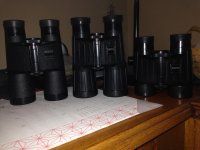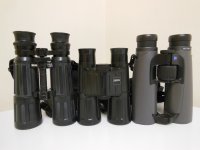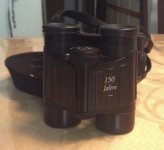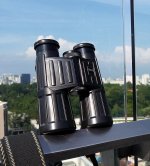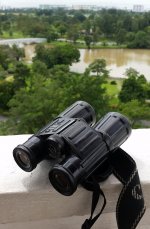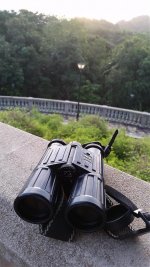james holdsworth
Consulting Biologist
I recently acquired a minty specimen Zeiss 10x40 BGAT/P, later run with what I would assume to be the most-up-to-date coatings etc. This specimen is virtually unmarked, with pristine optics and near perfect mechanicals - about 2mm lash in the focus is about the only thing to harp on.
I have a leatherette version 10x40 BT and hoped that scratched my itch for this model, but the BT’s perfect cosmetic condition as well as its' mediocre optical performance meant it sat on the shelf more as a monument to the company than a useful tool. So, thoughts went to the BGAT version. As a young bird bander in the early 80's, I saw this model slung from the necks of the many imported brit / euro birders than manned the banding station at Long Point. It was this model that showed me that a binocular could be desirable, beautiful as well as useful and practical. At the time I was blissfully happy with my 7x35 Skylines and any thought of dropping a grand on a bino was complete fantasy....then I was lucky to make a few thousand for my entire year! But I told myself, when I have the money I will have that binocular. As it happened, when I got the money, the only premium brand I could actually buy anywhere near my small town was a Bausch and Lomb Elite - so I went that route and the Zeiss were temporarily forgotten.
So, fast forward and I'm thinking that I've got many iconic Zeiss models but lack that actual model that started me down the collector path in the 1st place, the model of Zeiss that I still consider the most handsome, the most iconic and the most emblematic of the brand. Reading most of the reviews, one could expect an optic to nearly rival today’s top glass. I remember when 1st joining the forum, I opined vigorously that my 14 year old Elite was just as good as all the alpha stuff people were spending way too much time talking about. I also remember Henry telling me that, if you had the chance to compare them directly with current glass, it would be likely my opinion would change. Henry was, of course, correct and the same could certainly be said of the Zeiss 10x40 BGAT/P.
Optical impressions? Well, quaint and nostalgic come to mind. I remember thinking how brilliant, how sharp and contrasty these were when I was young. Fairly or not, they cannot compete with even mid-tier binoculars of today and, considering this model was a standard bearer at the time, reminds me that optics [roofs at least] have improved quite vastly over the past twenty years.
The view, for the era, was indeed sharp and contrasty but, in direct comparison with my mid 90’s Elite, contrast is a bit lower than that model. Something striking right off the bat, especially in Ontario’s gray and overcast winter norms, is a rather weak and dull colour saturation, mostly due to low transmission – looking like something in the low 80’s. But matters are not helped by whites being distinctly yellowish and the colour balance skewed towards brownish-red.
The field is well corrected but blighted by what seems to be AMD, causing edges to squeeze and roll, especially side to side. What you end up with is minor but annoying rolling ball. This same characteristic is found in the much older pre P version of the 10x40 and I would have thought, after more than 10 years, Zeiss would have chosen to correct this. Apparently not a big deal for most as this trait is rarely mentioned when someone does a current review of this binocular, which I might assume is individual sensitivity.
CA correction is good centrally with some being visible towards the edges with some inducement. Like its’ Dialyt brothers, simpler designs seem less likely to produce objectionable CA. A fair bit is visible on flying birds, in back-lit conditions though.
Glare / flare control is poor. Peripheral bright light produces annoying flickering flare at the field edges. Strong forward lighting causes an almost total veiling glare washout. Spill-light, getting behind the rubber eyecups, also contributes to lower contrast images. Again, this poor stray-light control is hardly mentioned in modern and historic reviews.
Funny thing, the 10x40’s smaller brother, the 8x30 BGAT/P, that shares the same chassis, is better optically – better whites, better colour fidelity and less field distortion but suffers from some of the same stray light control problems. Then again, the 7x42 BGAT/P is considerably better than either – brighter, more saturated colours and a more contrasty, more contemporary view.
Overall, I wasn’t really that disappointed in the performance, having viewed most reviews as likely coloured by ownership bias. I bought it for looks and as an iconic part of my collection, as well as occasional field use. Having bins like this to switch up from time to time reinforces the positive attributes of my more modern glass. I guess no one expects a 20 year old Porsche to compete with a contemporary model and they should be driven with a realization that time and development were bound to improve the breed. They are a handy pair though, so trim and light in the hand and look cool around one’s neck, even if the view isn’t world-beating.
I have a leatherette version 10x40 BT and hoped that scratched my itch for this model, but the BT’s perfect cosmetic condition as well as its' mediocre optical performance meant it sat on the shelf more as a monument to the company than a useful tool. So, thoughts went to the BGAT version. As a young bird bander in the early 80's, I saw this model slung from the necks of the many imported brit / euro birders than manned the banding station at Long Point. It was this model that showed me that a binocular could be desirable, beautiful as well as useful and practical. At the time I was blissfully happy with my 7x35 Skylines and any thought of dropping a grand on a bino was complete fantasy....then I was lucky to make a few thousand for my entire year! But I told myself, when I have the money I will have that binocular. As it happened, when I got the money, the only premium brand I could actually buy anywhere near my small town was a Bausch and Lomb Elite - so I went that route and the Zeiss were temporarily forgotten.
So, fast forward and I'm thinking that I've got many iconic Zeiss models but lack that actual model that started me down the collector path in the 1st place, the model of Zeiss that I still consider the most handsome, the most iconic and the most emblematic of the brand. Reading most of the reviews, one could expect an optic to nearly rival today’s top glass. I remember when 1st joining the forum, I opined vigorously that my 14 year old Elite was just as good as all the alpha stuff people were spending way too much time talking about. I also remember Henry telling me that, if you had the chance to compare them directly with current glass, it would be likely my opinion would change. Henry was, of course, correct and the same could certainly be said of the Zeiss 10x40 BGAT/P.
Optical impressions? Well, quaint and nostalgic come to mind. I remember thinking how brilliant, how sharp and contrasty these were when I was young. Fairly or not, they cannot compete with even mid-tier binoculars of today and, considering this model was a standard bearer at the time, reminds me that optics [roofs at least] have improved quite vastly over the past twenty years.
The view, for the era, was indeed sharp and contrasty but, in direct comparison with my mid 90’s Elite, contrast is a bit lower than that model. Something striking right off the bat, especially in Ontario’s gray and overcast winter norms, is a rather weak and dull colour saturation, mostly due to low transmission – looking like something in the low 80’s. But matters are not helped by whites being distinctly yellowish and the colour balance skewed towards brownish-red.
The field is well corrected but blighted by what seems to be AMD, causing edges to squeeze and roll, especially side to side. What you end up with is minor but annoying rolling ball. This same characteristic is found in the much older pre P version of the 10x40 and I would have thought, after more than 10 years, Zeiss would have chosen to correct this. Apparently not a big deal for most as this trait is rarely mentioned when someone does a current review of this binocular, which I might assume is individual sensitivity.
CA correction is good centrally with some being visible towards the edges with some inducement. Like its’ Dialyt brothers, simpler designs seem less likely to produce objectionable CA. A fair bit is visible on flying birds, in back-lit conditions though.
Glare / flare control is poor. Peripheral bright light produces annoying flickering flare at the field edges. Strong forward lighting causes an almost total veiling glare washout. Spill-light, getting behind the rubber eyecups, also contributes to lower contrast images. Again, this poor stray-light control is hardly mentioned in modern and historic reviews.
Funny thing, the 10x40’s smaller brother, the 8x30 BGAT/P, that shares the same chassis, is better optically – better whites, better colour fidelity and less field distortion but suffers from some of the same stray light control problems. Then again, the 7x42 BGAT/P is considerably better than either – brighter, more saturated colours and a more contrasty, more contemporary view.
Overall, I wasn’t really that disappointed in the performance, having viewed most reviews as likely coloured by ownership bias. I bought it for looks and as an iconic part of my collection, as well as occasional field use. Having bins like this to switch up from time to time reinforces the positive attributes of my more modern glass. I guess no one expects a 20 year old Porsche to compete with a contemporary model and they should be driven with a realization that time and development were bound to improve the breed. They are a handy pair though, so trim and light in the hand and look cool around one’s neck, even if the view isn’t world-beating.
Attachments
Last edited:




